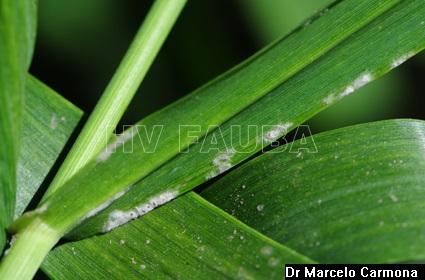.
Condición fitosanitaria: Presente ampliamente distribuida
Grupo de cultivos: Cereales
Especie hospedante: Cebada (Hordeum vulgare; Hordeum vulgare var. distichon (L.) Hook.f., 1896)
Rango de hospedantes: específico / estrecho
Etiología: Hongo. Biotrófico
Agente causal: Blumeria graminis f. sp hordei (DC.) E. O. Speer (syn. Erysiphe graminis f. sp. hordei) (teleomorfo),
Oidium monilioides Link 1824 (anamorfo)
.
Taxonomía: Fungi > Dikarya > Ascomycota > Pezizomycotina > Leotiomycetes > Erysiphales > Erysiphaceae > Blumeria > Blumeria graminis
.
.
Antecedentes
En Argentina es de poca importancia pero en Brasil, puede causar daños significativos.
.
Síntomas y signos
Puede afectar toda la parte aérea de la planta, pero ataca fundamentalmente las hojas y vainas de las hojas inferiores. Las plantas afectadas producen granos chuzos. Se observa un micelio superficial velloso de color blanco. En ataques tempranos e intensos provoca pérdidas de hojas y menor número de granos.
.
.
Ciclo de la enfermedad y epidemiología
Ataca cebada y algunas otras especies del género Hordeum. La principal fuente de inóculo son las plantas guachas. Por encima de los 25 ºC el hongo frena su desarrollo, por lo que es común observarla principalmente en macollaje. Para la germinación de las esporas no necesita agua libre. Los conidios son diseminados por el viento a varios kilómetros y el patrón de distribución en el lote es generalizado y uniforme.
.
Esquema del ciclo de la enfermedad
.
Condiciones predisponentes
Alta humedad (85-100 %) y temperaturas relativamente frescas (15-22 ºC).
.
Manejo
Evitar el uso de cultivares susceptibles, alta densidad de plantas y excesivas dosis de nitrógeno.
.
.
Bibliografía
Aghnoum R, Marcel TC, Johrde A, et al. (2010) Basal Host Resistance of Barley to Powdery Mildew: Connecting Quantitative Trait Loci and Candidate Genes. Molecular Plant-Microbe Interactions 23(1): 91-102. doi: 10.1094/MPMI-23-1-0091
Balkema‐Boomstra AG, Mastebroek HD (1995) Effect of powdery mildew (Erysiphe graminis f.sp. hordei) on photosynthesis and grain yield of partially resistant genotypes of spring barley (Hordeum vulgare L.). Plant Breeding 114: 126-130. doi: 10.1111/j.1439-0523.1995.tb00776.x
Braun U (2012) The impacts of the discontinuation of dual nomenclature of pleomorphic fungi: the trivial facts, problems, and strategies. IMA Fungus 3: 81–86. doi: 10.5598/imafungus.2012.03.01.08
Braun U (2013) (2210–2232) Proposals to conserve the teleomorph–typified name Blumeria against the anamorph–typified name Oidium and twenty–two teleomorph–typified powdery mildew species names against competing anamorph–typified names (Ascomycota: Erysiphaceae). Taxon, 62: 1328-1331. doi: 10.12705/626.20
Brugger A, Schramowski P, Paulus S, et al. (2021) Spectral signatures in the UV-range can be combined with secondary plant metabolites by deep learning to characterise barley – powdery mildew interaction. Plant Pathology. Accepted Author Manuscript. doi: 10.1111/ppa.13411
Emma E Crean, Merle Bilstein-Schloemer, Takaki Maekawa, et al. (2023) A dominant-negative avirulence effector of the barley powdery mildew fungus provides mechanistic insight to barley MLA immune receptor activation. bioRxiv 2023.01.11.523539; doi: 10.1101/2023.01.11.523539
Ge X, Deng W, Lee ZZ, et al. (2016) Tempered mlo broad-spectrum resistance to barley powdery mildew in an Ethiopian landrace. Nature Scientific Reports 6, Article number: 29558. doi: 10.1038/srep29558
Gjetting T, Carver TLW, Skøt L, Lyngær MF (2004) Differential gene expression in individual papilla-resistant and powdery mildew-infected barley epidermal cells. Molecular Plant–Microbe Interactions 17: 729–738. doi: 10.1094/MPMI.2004.17.7.729
Guo J, Zhao C, Gupta S, et al. (2024) Genome-wide association mapping for seedling and adult resistance to powdery mildew in barley. Theor Appl Genet 137: 50. doi: 10.1007/s00122-024-04550-y
Haugaard H, Collinge DB, Lyngkjær MF (2002) Mechanisms involved in control of Blumeria graminis f.sp. hordei in barley treated with mycelial extracts from cultured fungi. Plant Pathology 51: 612-620. doi: 10.1046/j.1365-3059.2002.00748.x
Kruger WM, Szabo LJ, Zeyen RJ (2003) Transcription of the defense response genes chitinase IIb, PAL, and peroxidase is induced by the barley powdery mildew fungus and is only indirectly modulated by R genes. Physiological and Molecular Plant Pathology 63: 167–178. doi: 10.1016/j.pmpp.2003.10.006
Kusch S, Frantzeskakis L, Lassen BD, et al. (2021) A fungal plant pathogen overcomes conserved broad-spectrum disease resistance by rapid gene loss. bioRxiv 2021.12.09.471931; doi: 10.1101/2021.12.09.471931
Laupheimer S, Proels R, Unsicker SB, Huckelhoven R (2021) Volatile-mediated signaling induces resistance of barley against infection with the biotrophic fungus Blumeria graminis f. sp. hordei. bioRxiv 2021.12.08.471267; doi: 10.1101/2021.12.08.471267
Müller MC, Kunz L, Schudel S, et al. (2022) Ancient variation of the AvrPm17 gene in powdery mildew limits the effectiveness of the introgressed rye Pm17 resistance gene in wheat. Proc Natl Acad Sci U S A. 119(30): e2108808119. doi: 10.1073/pnas.2108808119
Németh MZ, Seress D, Nonomura T (2023) Fungi Parasitizing Powdery Mildew Fungi: Ampelomyces Strains as Biocontrol Agents against Powdery Mildews. Agronomy 13(8): 1991. doi: 10.3390/agronomy13081991
Skoppek CI, Punt W, Heinrichs M, et al (2021) The barley HvSTP13GR mutant triggers resistance against biotrophic fungi. Molecular Plant Pathology 00: 1– 13. doi: 10.1111/mpp.13161
Sørensen CK, Carciofi M, Hasler‐Sheetal H, et al. (2018) Overexpression of phytoglobin in barley alters both compatible and incompatible interactions with the mildew pathogen Blumeria graminis. Plant Pathology. doi: 10.1111/ppa.12931
, , (2022) Barley guanine nucleotide exchange factor HvGEF14 is an activator of the susceptibility factor HvRACB and supports host cell entry by Blumeria graminis f. sp. hordei. Molecular Plant Pathology 23: 1524-1537. doi: 10.1111/mpp.13246
Tucker MA, Moffat CS, Ellwood SR, et al. (2015) Development of genetic SSR markers in Blumeria graminis f. sp. hordei and application to isolates from Australia. Plant Pathology 64: 337-343. doi: 10.1111/ppa.12258
Zulak KG, Cox BA, Tucker MA, et al. (2018) Improved Detection and Monitoring of Fungicide Resistance in Blumeria graminis f. sp. hordei With High-Throughput Genotype Quantification by Digital PCR. Front. Microbiol. 9:706. doi: 10.3389/fmicb.2018.00706
